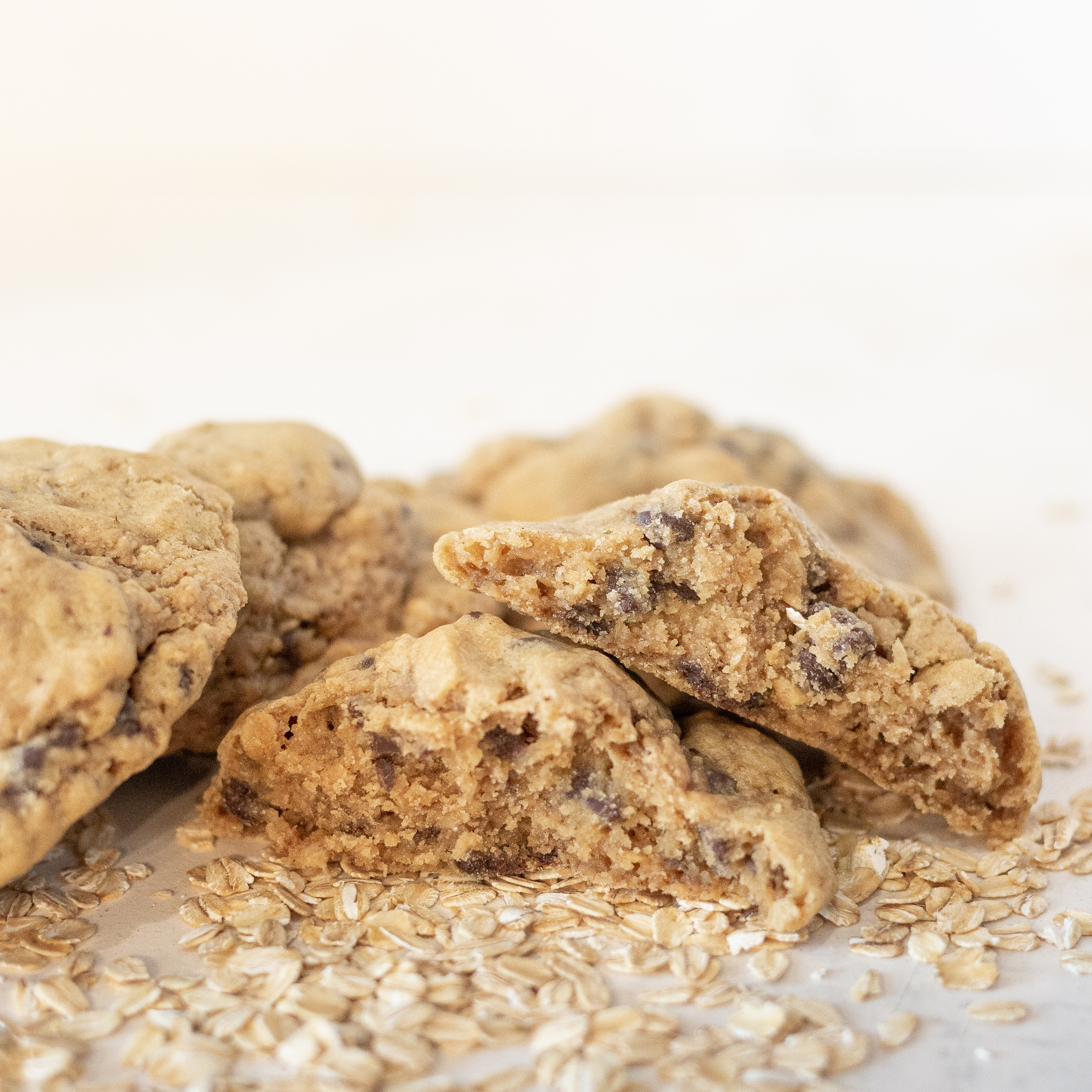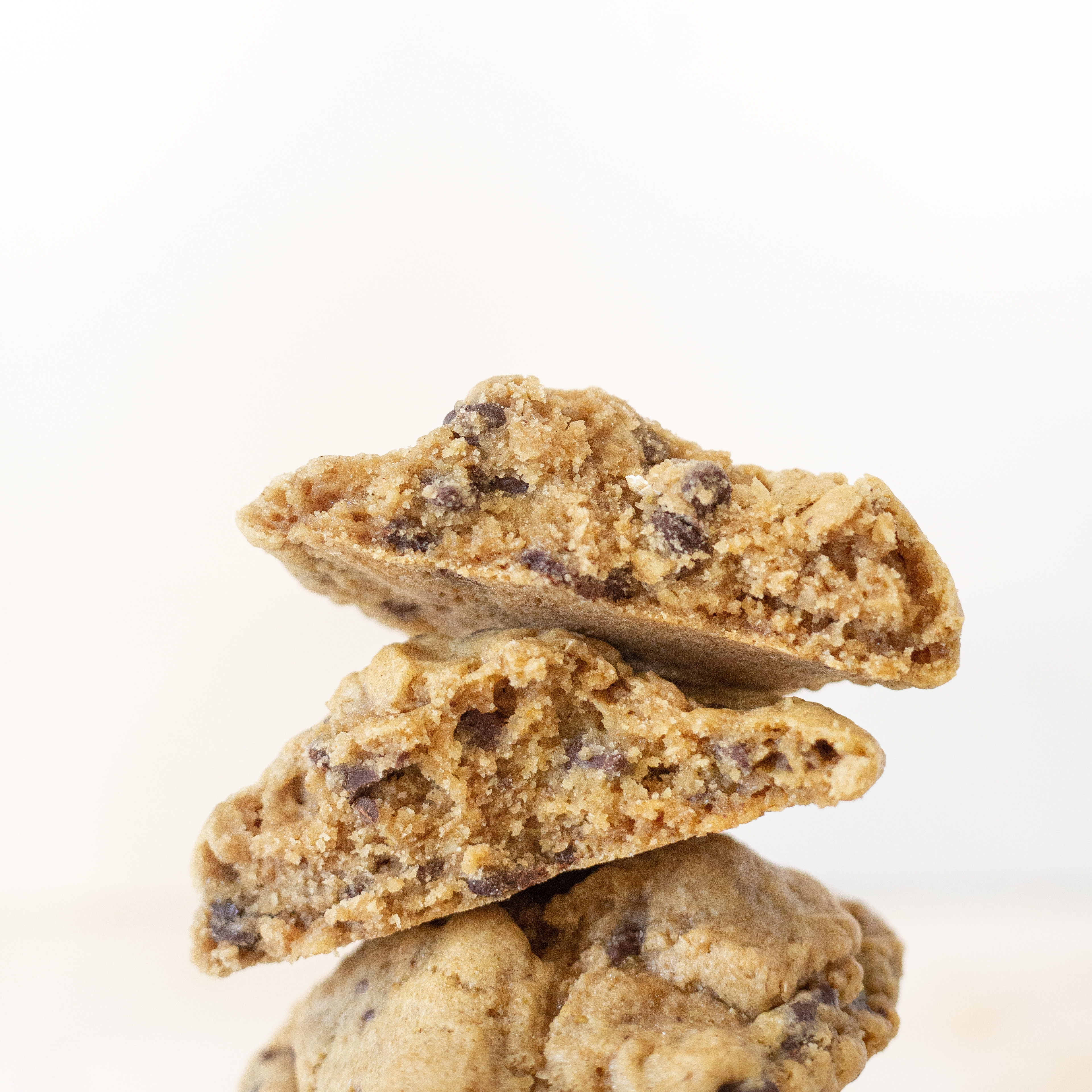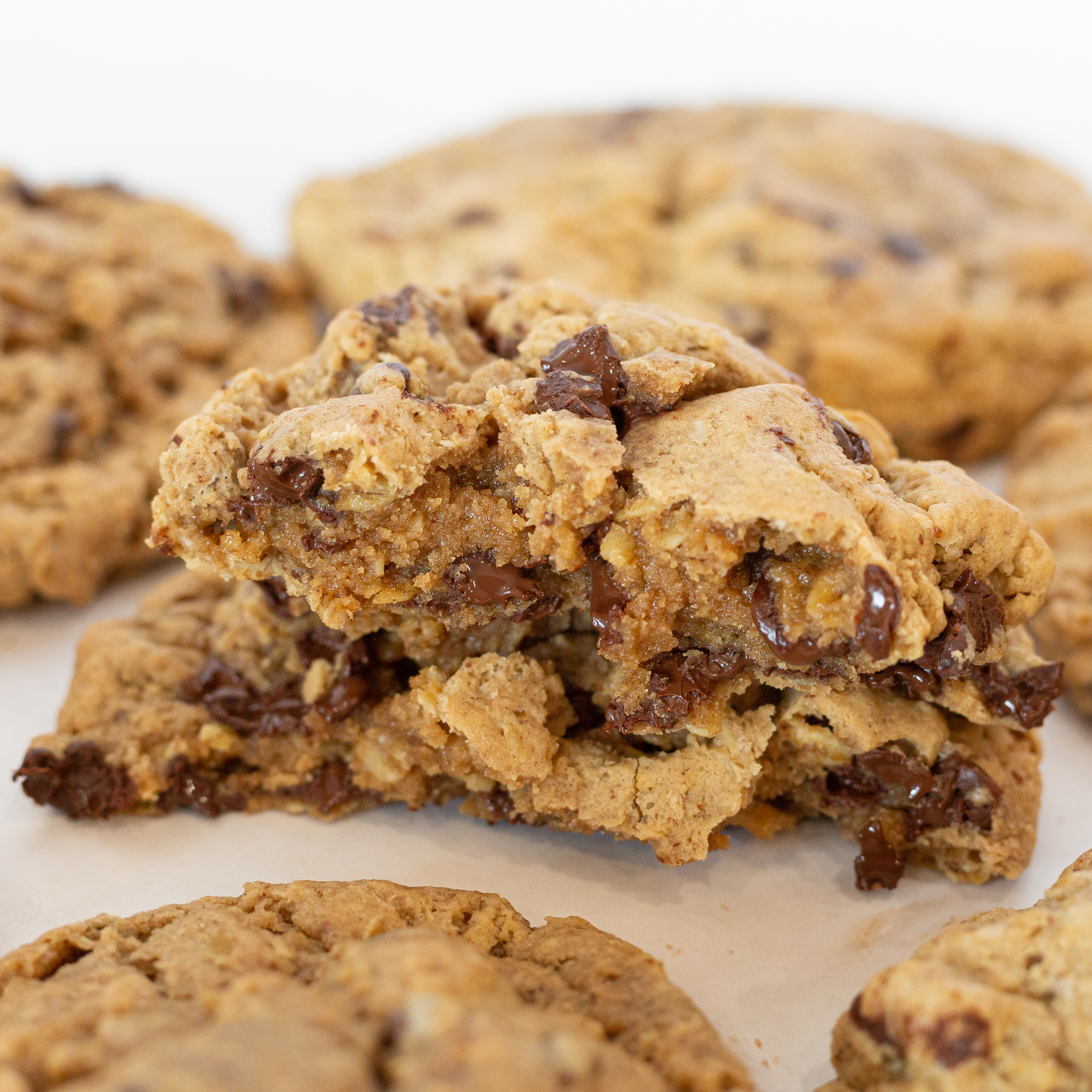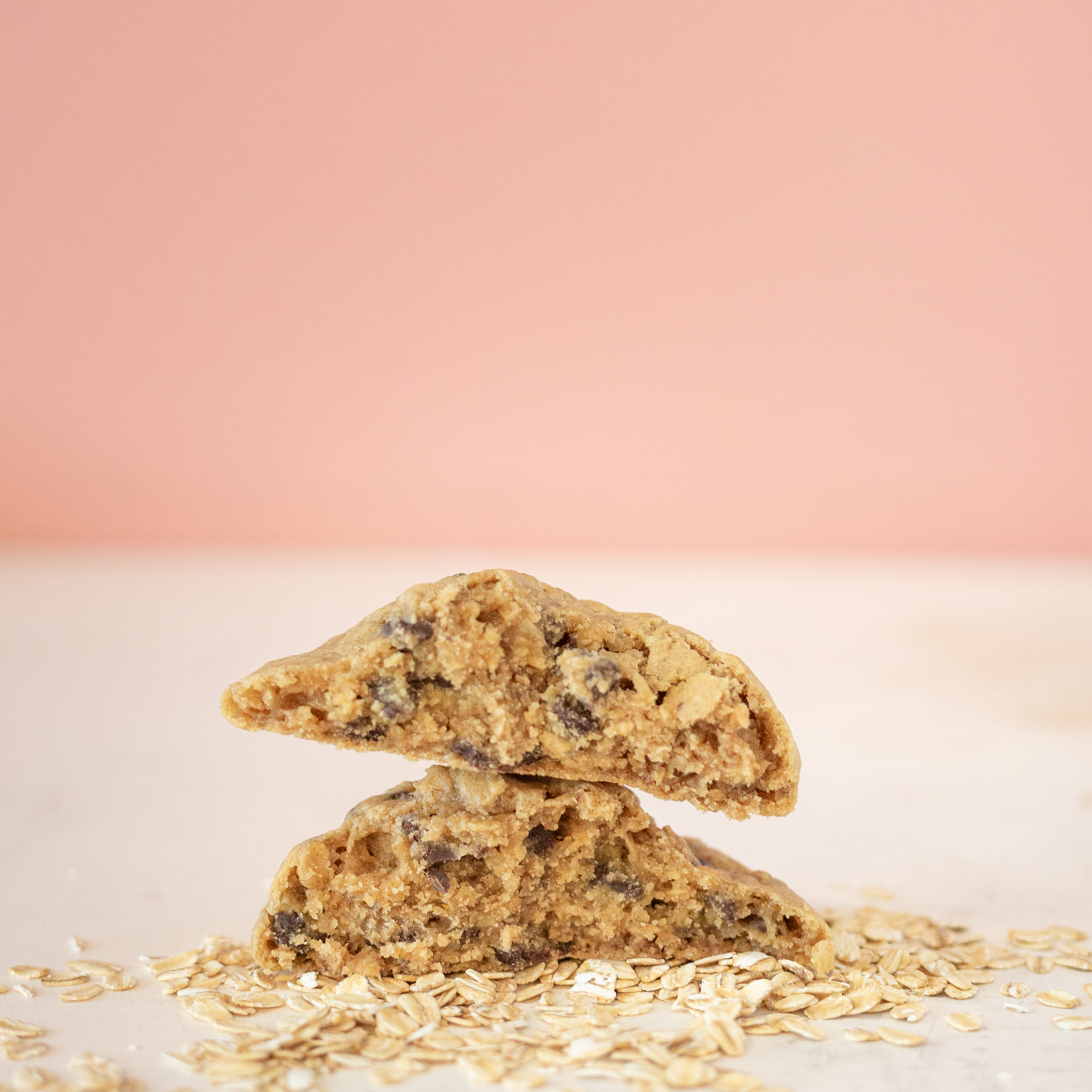For scrumptious oatmeal cookies, opt for old-fashioned rolled oats for that hearty, nutty vibe. Brown sugar packs a rich, caramel-ish sweetness punch while butter brings that luxurious flavor. All-purpose flour is your baking BFF, and vanilla extract adds a warm touch. Feeling fancy? Try some raisins or even chocolate chips for extra oomph. Don't forget the baking soda to make those cookies light and fluffy! Get ready for a flavor explosion and a texture party in every bite.
Key Takeaways
- Old-fashioned rolled oats for hearty texture and nutty flavor in classic oatmeal cookies.
- Brown sugar for rich sweetness that complements raisins well.
- Butter for a rich flavor profile in oatmeal cookies.
- All-purpose flour for versatile baking and experimenting with mix-ins.
- Baking soda for perfect rising and fluffy texture in oatmeal cookies.
Types of Oats
So, you're ready to make some delicious oatmeal cookies, huh? Well, let's start by talking about the different types of oats you can use. There's old-fashioned rolled oats, quick oats, and steel-cut oats—each bringing its unique texture and flavor to your cookie recipe.
Old-Fashioned Rolled Oats
When making oatmeal cookies, old-fashioned rolled oats are a classic ingredient that provides a hearty texture and nutty flavor. These oats are a staple in oatmeal cookie ingredients and are key to creating chewy oatmeal cookies that everyone loves. Whether you're baking up traditional oatmeal raisin cookies or indulging in the delightful combination of oatmeal and chocolate chips, old-fashioned oats are a must-have in your pantry. Looking to whip up a batch of mouth-watering oatmeal raisin cookies? Check out a classic oatmeal raisin cookie recipe that calls for these versatile oats.
Old-fashioned rolled oats are among the oatmeal cookie essentials that guarantee the perfect oatmeal cookie every time. Their rich, earthy taste adds depth to your cookies, making each bite a delightful experience.
Quick Oats
For a different texture and quicker cooking time in your oatmeal cookies, consider using quick oats as an alternative to old-fashioned rolled oats. Quick oats are cut finer than traditional oats, making them ideal for baking when you want a chewy texture and nutty flavor in your cookies. When preparing your favorite oatmeal cookie recipe, swap out the old-fashioned oats for an equal amount of quick oats to experience a delightful change in your baked treats.
To begin, gather your brown sugar, granulated sugar, quick oats, plump raisins, and other ingredients. In a medium bowl, mix the dry ingredients together, ensuring the quick oats are evenly distributed. The quick oats absorb moisture faster during baking, contributing to a chewier cookie texture. Spoon the cookie dough onto a baking sheet and watch as the quick oats help create perfectly plump and flavorful cookies.
Steel-Cut Oats
Consider incorporating steel-cut oats into your oatmeal cookie recipe for a hearty and unique twist on traditional rolled oats. Steel-cut oats are known for their nutty texture and molasses flavor, adding depth of flavor to your classic cookies. When used in oatmeal cookies, steel-cut oats provide a chewy center while still maintaining soft centers, creating a delightful contrast that enhances the overall cookie experience.
To make your oatmeal cookies soft and delicious using steel-cut oats, start with your favorite base recipe and simply swap out the rolled oats with an equal amount of steel-cut oats. The key is to make sure the oats are cooked beforehand to achieve that perfect texture in your cookies. Use a recipe with measurements specific to steel-cut oats to get the proportions just right and achieve the best results.
Sweeteners
Brown sugar, white sugar, or maybe you want to try something different like honey or maple syrup. Each brings a unique flavor profile to your cookies, so choose wisely based on your taste preferences.
Brown Sugar
Brown sugar adds a rich and caramel-like sweetness to oatmeal cookies. When you mix it into your chewy oatmeal cookie dough, it brings a depth of flavor that complements the sweet raisins perfectly. Using dark brown sugar instead of just granulated sugar in your recipe can take your cookies to the next level. A cup of raisins combined with the molasses notes from the brown sugar creates a delightful taste sensation in every bite.
If you're on a restrictive diet, you can still enjoy the deliciousness of oatmeal cookies by choosing healthier alternatives such as coconut sugar or a sugar substitute. However, if you're not restricted, incorporating brown sugar into the best baking ingredients will add a warm and comforting flavor to your treats. Don't skimp on this essential component that gives your cookies a unique taste that can't be replicated.
White Sugar
White sugar serves as a vital sweetener in oatmeal cookies, providing a simple and familiar taste profile to balance the flavors of other ingredients. When making your favorite chewy oatmeal cookie recipe, white sugar plays an essential role in creating that perfect level of sweetness that everyone loves. Whether you're adding in chocolate chips or keeping it traditional with just oats, the right amount of white sugar in your cookie dough is key to achieving those soft cookies that are irresistible.
In your quest to bake the best homemade cookies, don't underestimate the importance of white sugar in your baking arsenal. It not only enhances the flavor of your oatmeal cookies but also contributes to their texture, giving them that perfect balance of chewiness and sweetness.
Alternatives (Honey, Maple Syrup)
Consider incorporating honey or maple syrup as alternative sweeteners when making oatmeal cookies. These natural sweeteners offer a unique flavor profile that can elevate your cookie game. When using honey in your oatmeal cookie recipe, opt for a mild-flavored variety to make sure it doesn't overpower the other ingredients. Maple syrup, on the other hand, adds a rich, caramel-like sweetness that complements the oats beautifully.
Experimenting with these alternatives can bring a delightful twist to your baking adventures. Substituting white sugar with honey or maple syrup not only enhances the flavor but also provides a healthier option. These sweeteners bring a subtle complexity that can make your oatmeal cookies stand out from the crowd.
Fats
Butter, vegetable oil, and shortening are the key players here. Each brings its own unique flavor and texture to the table, so choose wisely!
Butter
You can substitute butter with a plant-based alternative like coconut oil for a dairy-free option in oatmeal cookie recipes. If you're looking to store your cookies, keep them in an airtight container once they've cooled. When baking, consider using unsalted butter to control the salt content in your treats. In a separate bowl, mix the butter with purpose flour until it forms a smooth consistency. Preheat your oven, line your cookie sheets with parchment paper, and scoop out the dough onto the sheets. As the cookies bake, the aroma will fill your kitchen, and you'll know they're done when they turn a lovely golden brown. If you have an electric mixer, it can help blend the ingredients seamlessly. Once the timer goes off, take out the baked cookies and let them cool before indulging.
Vegetable Oil
To explore a dairy-free alternative for fats in oatmeal cookies, consider using vegetable oil as a substitution for butter in your recipes. Vegetable oil is a great option for those looking to make homemade oatmeal cookies that are chewy and crispy. When baking with vegetable oil, make sure you use the right amount according to your recipe to maintain the perfect texture. This healthy substitution can add moisture to your cookies while still keeping them light.
In your oatmeal cookie recipe, try incorporating vegetable oil instead of butter for a different twist. The oil can enhance the flavors of the other ingredients and make your cookies unique. Whether you prefer a more chewy or crispy texture, adjusting the amount of vegetable oil in your recipe can help you achieve the desired outcome. Experiment with different types of vegetable oils to find the one that best suits your taste preferences. Making this simple change can lead to delicious oatmeal cookies that are both tasty and wholesome.
Shortening
Consider using shortening as a versatile alternative to butter or vegetable oil in your oatmeal cookie recipes. Shortening can give your cookies a different texture and flavor profile. Here are a few reasons why shortening might become your new favorite ingredient for baking cookies:
- Buttery Flavor: Shortening can impart a rich, buttery flavor to your oatmeal cookies, enhancing their taste.
- Crisp Edges: If you prefer oatmeal cookies with crisp edges, shortening can help achieve that perfect balance of crispy and chewy.
- Softer Cookies: Shortening can also be the key to baking softer cookies, whether you're making chewy oatmeal raisin cookies or a plain oatmeal cookie with a softer texture.
Flour Options
Let's talk about the heart of your cookie - the flour options. You've got all-purpose flour for a classic texture, whole wheat flour for a nutty flavor, and gluten-free alternatives for those with dietary restrictions.
All-Purpose Flour
When selecting flour for your oatmeal cookies, opt for all-purpose flour for a versatile baking experience. This type of flour is perfect for creating the ideal texture in your chocolate chip oatmeal cookies. Here are some essential ingredients to combine with the all-purpose flour for the best results:
- 1 teaspoon salt: Balances the sweetness in your cookies and enhances the flavors.
- 1 teaspoon baking soda: Helps your cookies rise and provides that perfect softness.
- 1 teaspoon vanilla extract: Adds a delightful aroma and flavor to your cookies.
Using all-purpose flour in your baking guarantees that your cookies turn out just right, whether you prefer old-fashioned whole or a more modern twist like white chocolate chips or butterscotch chips. Experimenting with different mix-ins while keeping all-purpose flour as your base can help you achieve the ideal taste and texture for your favorite type of cookie.
Whole Wheat Flour
Whole wheat flour provides a nutritious alternative to all-purpose flour for baking oatmeal cookies, offering a wholesome twist to your favorite treat. When you use whole wheat flour in your oatmeal cookie recipe, you're not only adding a nutty flavor but also increasing the fiber content, making your cookies a healthier indulgence. This ingredient is perfect for creating chewy and hearty cookies that are perfect for a snack or dessert. By mixing whole wheat flour with rolled oats, you're enhancing the texture and flavor profile of your homemade cookies. The combination of whole wheat flour and oats results in a cookie that is not only delicious but also filling and satisfying. If you're looking to add a healthy touch to your baking, whole wheat flour is a fantastic choice that doesn't compromise on taste. .
Gluten-Free Alternatives
Consider incorporating gluten-free flour options as substitutes for traditional wheat flour when making oatmeal cookies for those with gluten sensitivities or dietary preferences. Here are three fantastic alternatives to try in your next batch of chewy oatmeal cookies:
-
Almond Flour: Known for its nutty flavor, almond flour adds moisture and richness to your cookie dough. It's a gluten-free option that blends well with the other ingredients, resulting in a deliciously chewy texture.
-
Coconut Flour: This gluten-free alternative is highly absorbent, so a little goes a long way. Combine it with your dry ingredient mixture for a subtle coconut flavor that complements the oats and cinnamon beautifully.
-
Oat Flour: For a boost of oatmeal flavor, consider using oat flour in your cookie dough balls. This gluten-free option enhances the chewiness of the cookies while providing a familiar taste that oatmeal cookie lovers will adore.
Leavening Agents
Baking soda and baking powder are the dynamic duo in this category, working their chemical reactions to give your cookies that perfect texture and lift. These two ingredients are what will make your oatmeal cookies not just tasty but also beautifully light and airy.
Baking Soda
Using baking soda in oatmeal cookies helps them rise while baking, creating a light and fluffy texture. When incorporating this magical ingredient into your cookie dough, remember these essential tips:
- Proper Measurement: Make sure to accurately measure the baking soda to guarantee the cookies rise perfectly in the oven.
- Even Distribution: Mix the baking soda thoroughly into the cookie dough to ensure uniform rising during baking.
- Patience is Key: Allow the cookies to cool on the prepared baking sheet for a few minutes before transferring them to a wire rack. This helps them set and maintains the texture just right.
After mixing your dough at medium speed with the paddle attachment and adding that extra teaspoon of cinnamon for flavor, scoop the dough into balls using a cookie scoop.
Baking Powder
For light and airy oatmeal cookies, incorporating baking powder as one of the leavening agents is crucial. Baking powder is a key ingredient that helps your cookies rise and achieve that perfect fluffy texture. When adding baking powder to your cookie dough, make sure to mix it with ½ teaspoon of salt and ½ teaspoon of baking soda. These ingredients work together to create a chemical reaction that produces carbon dioxide gas, causing the dough to expand and rise during baking.
To make the most of baking powder in your oatmeal cookies, combine it with 1 cup of all-purpose flour and a pinch of table salt. Ensure that the baking powder is evenly distributed throughout the dry ingredients before incorporating it into the butter mixture. For a delicious twist, add 255g of old-fashioned whole chocolate chunks and dark brown sugar to create a rich and indulgent flavor profile. With the right balance of baking powder and other essential ingredients, your oatmeal cookies will turn out light, fluffy, and irresistibly delicious.
Flavor Enhancers
Let's talk about flavor enhancers – the secret weapons that make your cookies go from good to irresistible. Vanilla extract adds a warm sweetness, cinnamon and other spices bring depth, and a pinch of salt enhances all the flavors in perfect harmony.
Vanilla Extract
Enhance the rich taste of your oatmeal cookies by adding a splash of aromatic vanilla extract.
- Vanilla extract is a versatile ingredient that can elevate the flavors of various cookie recipes, including chocolate chip, cowboy, and monster cookies.
- A teaspoon of vanilla extract in your oatmeal cookie dough can bring out the sweetness of ingredients like chocolate chips, raisins, and peanut butter.
- The warm and comforting aroma of vanilla extract will fill your kitchen as your oatmeal cookies bake for 8-10 minutes, creating a cozy atmosphere while you wait for the delicious treats to be ready.
Cinnamon and Other Spices
To further elevate the flavor profile of your oatmeal cookies, consider incorporating a blend of cinnamon and other spices for a delectable twist. The warm, aromatic notes of cinnamon combined with a hint of nutmeg or cloves can truly take your cookies to the next level. When mixing up your flour mixture, be sure to add a generous sprinkle of cinnamon to infuse each bite with a cozy and inviting flavor.
As you prepare your unbaked cookie dough balls, imagine the delightful aroma that will fill your kitchen as the cookies bake in the preheated oven. The combination of cinnamon, dark brown sugar, and salted butter will create a rich and flavorful base for your oatmeal cookies. If your dough feels a bit sticky, pop it into the freezer for a few minutes to make shaping the cookies easier.
With each batch of cinnamon-spiced oatmeal cookies, you'll be greeted with a comforting and nostalgic taste that pairs perfectly with a glass of milk or a cup of tea.
Salt
Consider incorporating a pinch of salt into your oatmeal cookie dough to enhance the flavors and balance the sweetness of the ingredients.
- Salt helps to intensify the flavors of the other ingredients in the dough.
- It also helps to bring out the natural sweetness of the oats and brown sugar.
- A small amount of salt can make a significant difference in the overall taste of your cookies.
When preparing your dough per cookie, don't forget to add a sprinkle of salt to elevate the taste profile. Whether you prefer a softer or crispier cookie, salt plays an essential role in achieving the desired texture. Before placing your cookie dough on prepared cookie sheets, make sure to mix in the right amount of salt for that perfect balance.
Mix-Ins
Raisins and dried fruits bring a sweet, chewy twist, while chocolate chips offer a melty, indulgent touch. Nuts and seeds add a crunchy texture and a nutty flavor that takes your cookies to the next level.
Raisins and Dried Fruits
Enhance your oatmeal cookies with a burst of sweetness and chewiness by adding raisins and dried fruits as mix-ins. These delightful additions bring a juicy and flavorful twist to your classic oatmeal cookie recipe. Here are some tips to make the most out of these mix-ins:
-
Plump Raisins: Soak your raisins in warm water for about 10 minutes before adding them to the cookie dough. This step helps the raisins become plump and juicy, enhancing the overall texture of your cookies.
-
Assorted Dried Fruits: Experiment with a mix of dried fruits like cranberries, apricots, or cherries to add a variety of flavors and textures to your oatmeal cookies. Chop them into smaller pieces for even distribution throughout the dough.
-
Balanced Ratio: Aim for a balanced ratio of raisins and dried fruits to oatmeal cookie dough. A good rule of thumb is to add around 1 cup of mix-ins for every 255g of cookie dough to make sure that every bite is filled with fruity goodness.
Chocolate Chips
To guarantee a decadent twist to your oatmeal cookies, incorporate rich and melty chocolate chips as your mix-ins. The combination of chewy oats and gooey chocolate creates a delightful contrast in texture and flavor. To start, make sure you have all your ingredients ready: 1 cup of all-purpose flour, 255g of old-fashioned whole oats, dark brown sugar, and of course, those delicious chocolate chips. According to ESHA Research, incorporating chocolate chips adds a touch of indulgence to your cookies without overpowering the oatmeal flavor.
When preparing your dough, follow your perfect recipe for oatmeal cookies. Once you have mixed in the chocolate chips, scoop out tablespoons of dough and roll them into smooth balls. The chocolate chips will melt and spread throughout the cookie as it bakes, creating pockets of gooey goodness in every bite.
Nuts and Seeds
To add a crunchy and nutritious element to your oatmeal cookies, consider incorporating a mix of nuts and seeds into your dough.
- Walnuts: Walnuts are a classic choice for oatmeal cookies, offering a rich, buttery flavor that pairs perfectly with the oats. They provide a satisfying crunch and are packed with heart-healthy omega-3 fatty acids.
- Pumpkin Seeds: Adding pumpkin seeds to your oatmeal cookie dough not only introduces a delightful crunch but also brings a subtle nutty flavor. These seeds are a good source of protein and add a pop of green color to your cookies.
- Almonds: Almonds are another fantastic option to include in your oatmeal cookie mix. They bring a slightly sweet taste and a satisfying crunch, enhancing the overall texture of the cookies. Plus, almonds are rich in vitamin E and healthy fats, making them a nutritious choice for your baking endeavors.
Binding Agents
Let's talk binding agents, specifically eggs or egg substitutes. These ingredients are essential for holding your cookie dough together and giving your treats that perfect chewy texture.
Eggs
Using eggs in your oatmeal cookie recipe will help bind all the ingredients together, creating a chewy and delicious cookie. Eggs are an essential component in baking, and they play an important role in holding everything together. Here are a few reasons why eggs are necessary for your oatmeal cookies:
- Binding Agent: Eggs act as a binder, bringing the dry and wet ingredients together to form a cohesive dough.
- Moisture: Eggs add moisture to the cookie dough, ensuring that your cookies turn out soft and chewy.
- Structure: The proteins in eggs help give structure to the cookies, contributing to their texture and overall deliciousness.
Egg Substitutes
Think about using various egg substitutes as binding agents in your oatmeal cookie recipe to achieve similar results as using traditional eggs. If you're out of eggs or following a vegan diet, fear not, there are plenty of options available to maintain that perfect cookie texture. One common substitute is applesauce, which not only binds the ingredients together but also adds a hint of natural sweetness. Another great alternative is mashed bananas, providing moisture and a subtle fruity flavor to your cookies. For a nutty twist, you can opt for almond butter or peanut butter, both of which work wonders as binding agents. Flaxseed mixed with water creates a gel-like consistency that mimics the binding properties of eggs. And for a protein-packed substitute, try using silken tofu blended into a smooth puree. Experiment with these egg substitutes to find the perfect match for your oatmeal cookie recipe, keeping in mind the flavor profile you desire and any dietary restrictions you need to take into account.
Liquid Ingredients
The liquid ingredient to ponder is milk, which helps to moisten the dough and create a soft texture.
Milk
Add a splash of milk to your oatmeal cookie dough for extra richness and moisture. Milk not only enhances the flavor but also helps create a soft and chewy texture that everyone loves. Here are three reasons why milk is an essential ingredient in making the perfect oatmeal cookies:
- Richness: Milk adds a creamy richness to the dough, making your cookies more flavorful and satisfying with every bite.
- Moisture: The moisture from the milk guarantees that your cookies stay moist and fresh, even days after baking.
- Binding Agent: Milk acts as a binding agent, helping all the ingredients come together seamlessly to form the perfect cookie dough consistency.
The Taylors and Taylor Chip
Baking together as a fun activity outside of their typical date nights, Sara and Dougie, known as The Taylors, discovered their passion for sweets and perfected the Taylor Chip oatmeal cookie. It all started back in 2015 when Sara and Dougie were newly dating and realized they shared a love for all things sweet. They decided to try their hand at baking, and boy, did they get hooked! The kitchen became their playground, and as they mixed and measured, their bond grew stronger.
After about a year of experimenting and taste-testing (tough job, right?), Sara and Dougie finally nailed it - the Taylor Chip oatmeal raisin cookie was born! It was a moment of sheer cookie perfection, just in time for their wedding. The blend of oats, butter, and those special Taylor Chips created a cookie that was not just a treat for the taste buds but a symbol of their love and dedication to their craft. The Taylors had truly found their sweet spot.
The Taylor Chip Oatmeal Raisin Cookie
Crafted with a blend of high-quality ingredients, the Taylor Chip Oatmeal Raisin Cookie offers a delightful combination of softness and decadence. Here's why this cookie is a must-try:
- Gooey Goodness: This cookie boasts a huge, soft texture that oozes gooey deliciousness with every bite.
- Perfectly Raisined: Enjoy just the right amount of plump raisins scattered throughout, adding a burst of sweetness to every mouthful.
- Warm Cinnamon Finish: A light hint of cinnamon wraps up the flavor profile, leaving a cozy and comforting taste lingering on your palate.
Imagine sinking your teeth into a freshly baked Taylor Chip Oatmeal Raisin Cookie, where the flavors of oats, butter, and cinnamon blend harmoniously to create a treat that's both familiar and exciting. Each cookie is handcrafted with care in Lancaster, Pennsylvania, using only the finest ingredients available, ensuring that every bite is a taste of perfection. Indulge in this decadent delight that promises to satisfy your sweet cravings and elevate your oatmeal cookie experience to new heights.
Frequently Asked Questions
Can I Substitute a Liquid Sweetener for a Granulated One in Oatmeal Cookies?
Sure, you can totally switch up your sweeteners in oatmeal cookies! Liquid sweeteners like honey or maple syrup can work instead of granulated ones. Just keep in mind that they might alter the texture a bit, so adjust your recipe accordingly. Play around with quantities to get that perfect balance of sweetness and moisture. Experimenting in the kitchen is half the fun, right? Go ahead, give it a shot and see how it turns out!
How Can I Make Oatmeal Cookies Gluten-Free Without Compromising Taste?
To make oatmeal cookies gluten-free without skimping on flavor, you can swap out regular flour for a gluten-free flour blend. This way, you maintain that tasty texture while catering to dietary needs. Some folks also swear by using certified gluten-free oats to be extra cautious. By making these simple switches, you can whip up a batch of delightful oatmeal cookies that everyone can enjoy, whether they're gluten-free or not!
Are There Any Alternatives to Butter for a Healthier Oatmeal Cookie Option?
Looking to swap out butter for a healthier spin on oatmeal cookies? You've got options! Try using coconut oil for a tropical twist or applesauce for a moist, fruity kick. Avocado can add a creamy texture while still being a better-for-you choice. Experiment with these swaps to find the one that suits your taste buds best. Your oatmeal cookies can be both delicious and nutritious with these creative alternatives!
Can I Use Whole Wheat Flour Instead of All-Purpose Flour in Oatmeal Cookies?
Sure, you can totally swap all-purpose flour for whole wheat flour in your oatmeal cookies. Whole wheat flour adds a nutty flavor and extra fiber, making your cookies a bit healthier. Just remember, whole wheat flour can make your cookies denser, so you might need to adjust your recipe a bit. Don't be afraid to experiment and find the perfect balance that suits your taste buds!
What Is the Best Way to Prevent Oatmeal Cookies From Spreading Too Much While Baking?
To prevent oatmeal cookies from spreading too much while baking, try chilling the dough before popping it into the oven. This step helps solidify the fats in the dough, keeping your cookies from turning into pancake shapes. Give the dough a little time to relax in the fridge, and you'll be rewarded with cookies that hold their shape beautifully. So, when in doubt, just chill out that dough!
Conclusion
In the end, whether you prefer chewy or crispy, raisins or chocolate chips, the best oatmeal cookies start with quality ingredients. From oats to sweeteners to fats, each component plays an essential role in creating the perfect cookie. So, don't be afraid to experiment and find your own favorite combination. And who knows, maybe you'll discover a new twist, like the Taylor Chip, that will become a family favorite for years to come. Happy baking!











